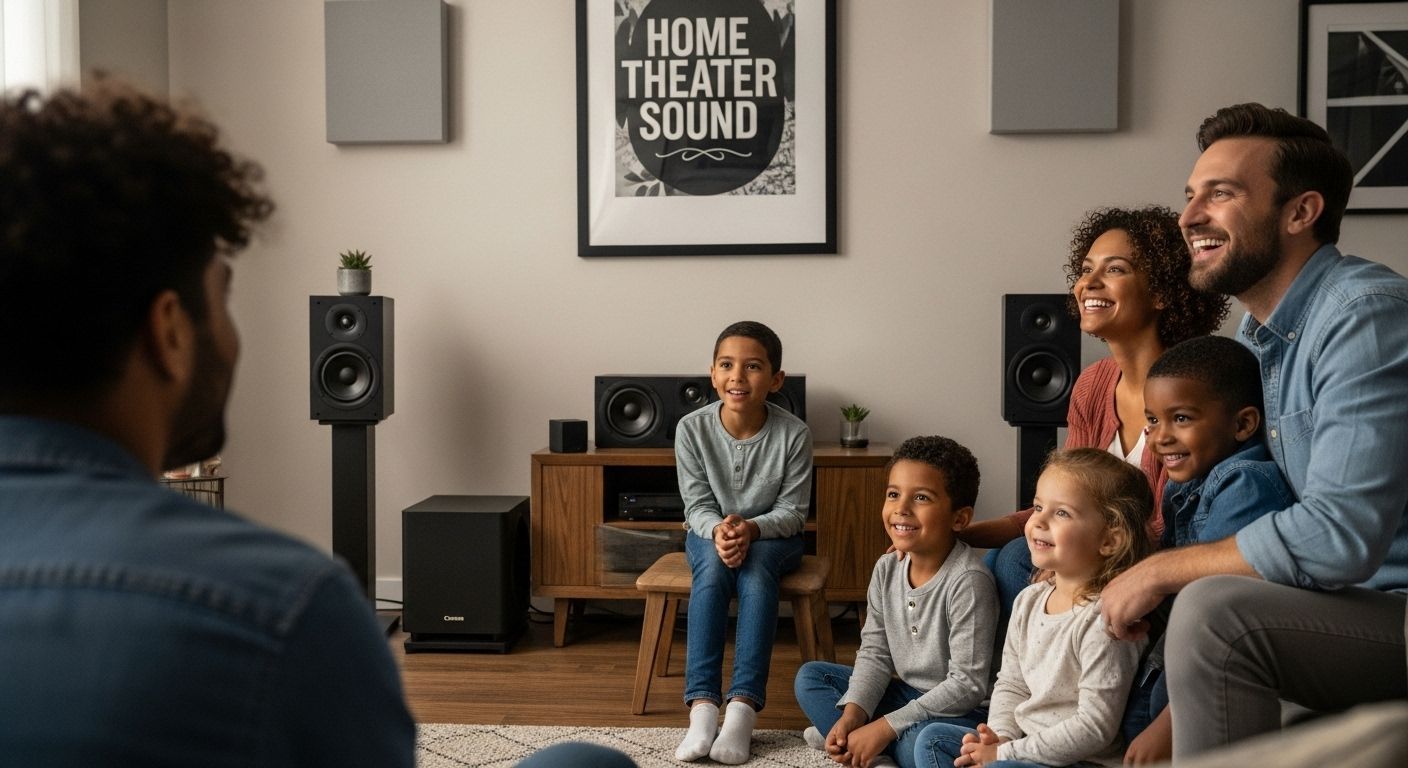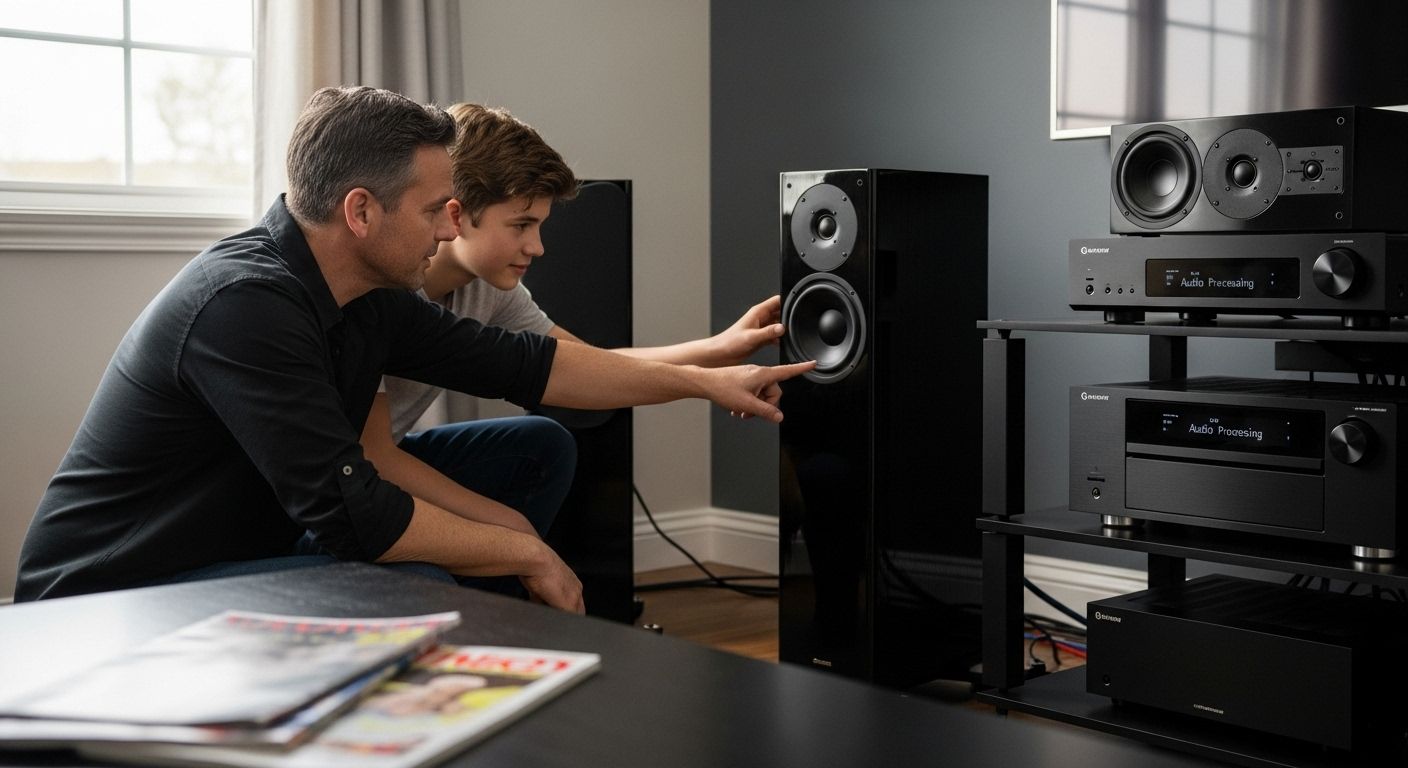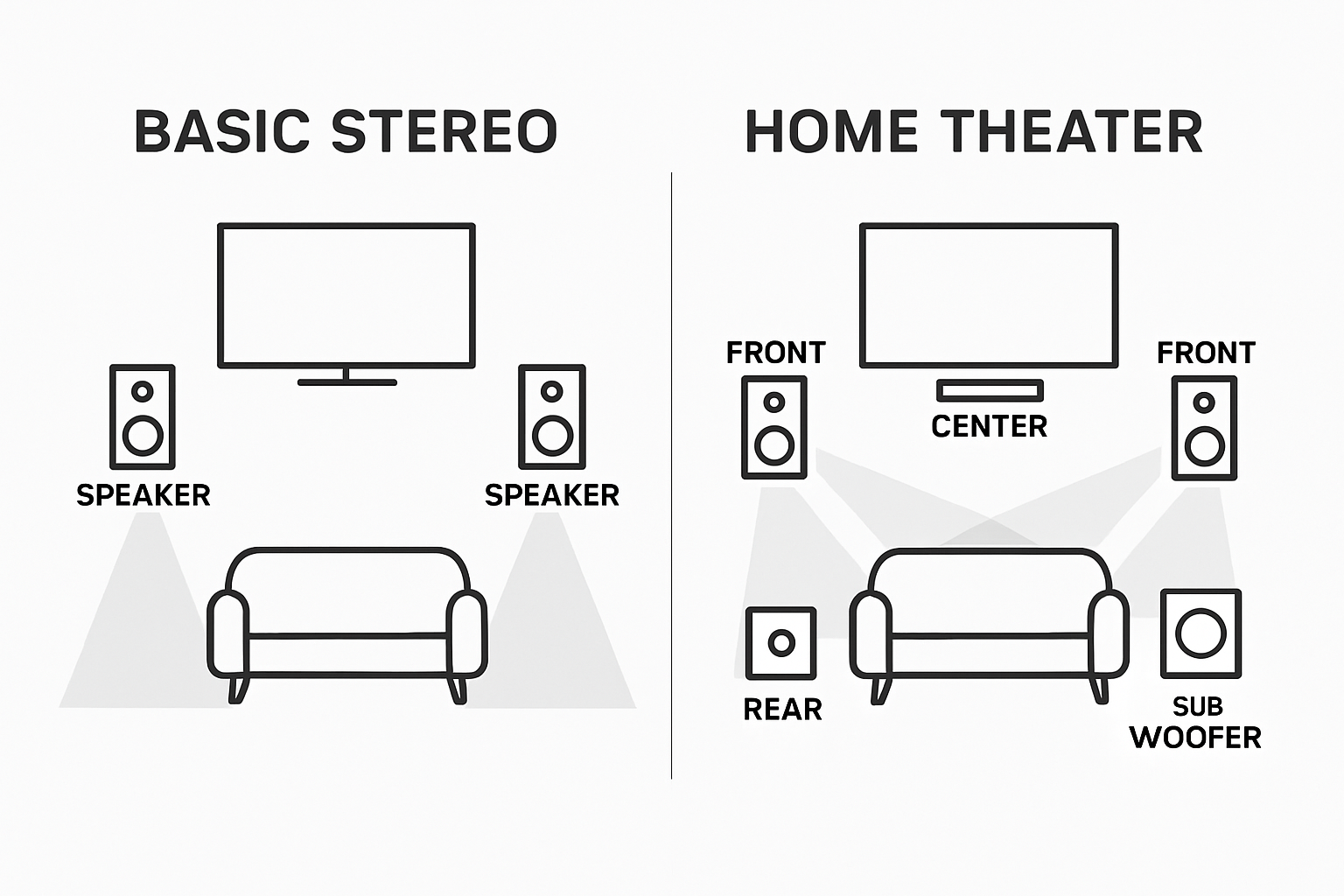Understanding Home Theater Sound Explained
- garygarihanjr
- Sep 7
- 9 min read

Home theater sound does more than fill a room with noise. It turns your living space into a set, where explosions crash from behind and whispers dance across the walls. But get this. A true home theater setup can feature up to 11 different speakers working together and creating a three-dimensional sound bubble around you. Most people think it’s all about louder volume and bigger bass, but the real magic is how these systems trick your brain into feeling every moment as if you are right inside the action.
Table of Contents
Quick Summary
Takeaway | Explanation |
Home theater sound enhances immersion. | It creates a multidimensional audio experience, making viewers feel part of the action. |
High-quality sound influences emotions. | Superior audio can evoke feelings and enhance the impact of storytelling during media consumption. |
Speaker placement is crucial for sound quality. | The strategic arrangement of speakers creates a three-dimensional soundstage that enriches audio experiences. |
Advanced audio technologies enable complex sound reproduction. | Innovations like Dolby Atmos and DTS decode multichannel formats for realistic sound environments. |
Home theater systems have diverse applications. | They are used not only in entertainment but also in training and educational environments for effective learning. |
What is Home Theater Sound?
Home theater sound represents a sophisticated audio technology designed to create an immersive entertainment experience that transforms how you perceive sound within your living space. Unlike traditional stereo systems that provide basic left and right channel audio, home theater sound delivers a multidimensional acoustic environment that makes viewers feel like they are part of the action.
The Core Components of Home Theater Sound
At its foundation, home theater sound is built around a complex audio processing system that goes beyond simple sound reproduction. Learn more about the essential home theater features that contribute to an exceptional audio experience. The system typically involves multiple speakers strategically positioned to create a three-dimensional soundstage:
Center Channel Speaker: Handles dialogue and primary audio
Front Left and Right Speakers: Provide directional sound effects
Surround Speakers: Create ambient and environmental audio
Subwoofer: Delivers deep bass frequencies
How Home Theater Sound Works
According to HandWiki’s overview of surround sound, the technology works by utilizing multiple audio channels that envelop the listener. An audio/video (AV) receiver acts as the central processing unit, decoding complex sound signals from various sources like movies, music, and games. This receiver interprets multichannel audio formats such as Dolby Digital or DTS, distributing sound across different speakers to create a spatial audio experience.
The magic of home theater sound lies in its ability to recreate realistic sound environments. When watching an action movie, you do not just hear explosions you feel them emerging from different directions. The carefully engineered speaker configuration ensures that sound moves dynamically, matching on-screen movements and creating a sense of depth and dimensionality that traditional audio systems cannot achieve.
The Importance of Quality Sound in Home Theater
Quality sound transforms a basic viewing experience into an extraordinary sensory journey, turning your home entertainment space into a professional cinematic environment. Beyond mere audio reproduction, superior sound quality creates emotional connections, heightens storytelling impact, and provides an immersive experience that transcends traditional media consumption.
Psychological and Emotional Impact of Sound
Explore our comprehensive guide to whole home audio systems and understand how sound profoundly influences human perception. High-quality audio triggers powerful emotional responses, making viewers feel deeply connected to on-screen narratives. Professional sound engineers understand that audio quality can manipulate audience emotions, creating tension, excitement, or tranquility through precise acoustic engineering.
Sound quality influences audience engagement through several critical mechanisms:
Emotional Resonance: Precise sound reproduction enhances narrative storytelling
Psychological Immersion: Realistic audio environments trigger sensory responses
Physiological Reaction: High-fidelity sound can induce physical responses like increased heart rate
Technical Superiority and Sensory Experience
According to research from the Society of Motion Picture and Television Engineers, superior audio systems provide more than volume. They deliver nuanced sound landscapes where every whisper, footstep, and background noise becomes a deliberate artistic expression. Professional home theater sound systems reconstruct audio environments with microscopic precision, allowing viewers to distinguish between subtle acoustic details that standard speakers would completely miss.
The difference between average and exceptional sound lies in technological sophistication. Advanced audio processing technologies decode complex soundscapes, creating three-dimensional audio experiences that make viewers feel physically present within the narrative environment. Quality sound does not just complement visual content it becomes an integral storytelling mechanism that elevates entertainment from passive consumption to active emotional engagement.
How Home Theater Sound Works: The Basics
Home theater sound operates through a sophisticated system of audio processing and signal distribution that transforms ordinary sound into an extraordinary sensory experience. The technology goes far beyond simple speaker placement, involving complex electronic and acoustic engineering designed to recreate immersive audio environments.
Audio Signal Processing
Check out our guide on home theater myths and misconceptions to understand the nuanced world of sound reproduction. At the core of home theater sound is the audio/video receiver (AVR), a central hub that receives, decodes, and distributes audio signals from multiple sources. This device acts as a sophisticated interpreter, translating digital audio information into spatial sound experiences across multiple speakers.
The signal processing involves several critical stages:

Signal Reception: Capturing audio data from various input sources
Decoding: Interpreting multichannel audio formats like Dolby Atmos or DTS
Distribution: Routing specific sound elements to appropriate speakers
Channel Configuration and Speaker Placement
According to research from Crutchfield’s Learning Center, home theater sound systems are typically configured in standard channel arrangements like 5.1 or 7.1. These numbers represent the quantity and type of speakers in the system. A 5.1 configuration, for example, includes five speakers (center, front left, front right, rear left, rear right) and one subwoofer, creating a comprehensive sound environment.
Here is a quick comparison of standard home theater sound channel configurations, including the number and role of speakers in each setup.
Configuration | Number of Speakers | Description |
2.0 | 2 | Basic stereo sound with left and right speakers |
3.1 | 4 | Adds a center channel and subwoofer for improved dialogue and bass |
5.1 | 6 | Left, center, right, two surrounds, and a subwoofer for a complete surround experience |
7.1 | 8 | Adds two additional rear surround speakers for deeper immersion |
9.1/11.1 | 10/12 | Includes height or overhead speakers for enhanced three-dimensional sound (e.g., Dolby Atmos setups) |
The strategic placement of speakers is crucial for creating a three-dimensional soundstage. Each speaker serves a specific acoustic purpose: center channel speakers handle dialogue, front speakers manage primary sound effects, surround speakers generate ambient noise, and subwoofers produce low-frequency sounds. This meticulous arrangement allows sound to move dynamically, mimicking real-world audio experiences and creating a sense of depth and movement that standard stereo systems cannot achieve.

Key Components of Home Theater Sound Systems
Building a superior home theater sound system requires understanding the intricate ecosystem of audio equipment that works together to create an immersive sound experience. Each component plays a critical role in transforming raw audio signals into a rich, multidimensional soundscape that transports viewers into the heart of their entertainment.
The following table summarizes the primary components of a home theater sound system and the unique role each plays in producing a multidimensional audio experience.
Component | Purpose/Role |
Audio/Video Receiver (AVR) | Central hub for decoding and distributing audio signals |
Center Channel Speaker | Handles dialog and main central sounds |
Front Left & Right | Delivers directional primary audio and effects |
Surround Speakers | Provides ambient and environmental sound |
Subwoofer | Produces low-frequency bass effects |
Audio Source Devices | Supply content (Blu-ray players, streaming devices) |
Signal Processors | Decode audio formats like Dolby Atmos and DTS |
Amplification Circuits | Boost and refine audio signals for clarity |
Core Audio Processing Equipment
Explore our guide to must-have home theater features to understand the essential elements of a high-performance system. The audio/video receiver (AVR) stands as the central nervous system of home theater sound. This sophisticated device acts as a hub, receiving audio and video signals from multiple sources, decoding complex multichannel formats, and distributing sound to different speakers with precision and clarity.
Key components in the audio processing chain include:
Audio Source Devices: Blu-ray players, streaming devices, gaming consoles
Signal Processors: Decoding audio formats like Dolby Atmos and DTS
Amplification Circuits: Boosting and refining audio signals
Speaker Configuration and Acoustic Components
According to ENERGY STAR’s comprehensive guide, home theater sound systems typically incorporate multiple speaker types, each designed for specific acoustic purposes. The speaker ensemble forms the physical manifestation of sound reproduction, transforming electrical signals into audible experiences:
Center Channel Speaker: Handles primary dialogue and central audio elements
Front Left and Right Speakers: Manage stereo sound and directional effects
Surround Speakers: Generate ambient and environmental audio
Subwoofer: Produces low-frequency sounds and deep bass
The strategic selection and placement of these speakers create a three-dimensional soundstage that mimics professional cinema audio environments. Each speaker contributes unique acoustic characteristics, working in harmony to reconstruct sound with unprecedented depth and realism.
Real-World Applications of Home Theater Sound
Home theater sound technology extends far beyond entertainment, transforming how we experience audio across multiple domains. From immersive cinematic experiences to professional training environments, advanced sound systems have revolutionized our interaction with audio content, creating multisensory experiences that engage and inform.
Entertainment and Media Experiences
Check out our inspiring examples of custom home theaters to understand the evolving landscape of audio technology. Modern home theater sound systems transcend traditional viewing experiences by creating spatial audio landscapes that blur the lines between recorded media and reality. Viewers no longer passively consume content they become active participants in narratives, feeling every whisper, explosion, and musical nuance with unprecedented clarity and emotional depth.
Key entertainment applications include:
Cinema Simulation: Recreating professional theater acoustics
Gaming Immersion: Providing directional audio cues and environmental sounds
Music Performance: Reproducing live concert experiences with remarkable fidelity
Professional and Educational Applications
According to research from Virginia Tech’s Cube Audio Facility, advanced sound systems have significant applications beyond entertainment. Spatial audio technologies are increasingly used in professional training, scientific research, and educational environments where precise sound reproduction can enhance learning and understanding.
These applications demonstrate the versatility of home theater sound technologies:
Medical Training: Simulating complex auditory environments for surgical skill development
Architectural Acoustics: Modeling sound behaviors in complex spaces
Scientific Research: Analyzing and visualizing sound data through advanced audio processing
The profound impact of sophisticated sound systems lies in their ability to transform passive listening into an active, multisensory experience that transcends traditional audio reproduction.
Ready to Experience Real Home Theater Sound?
Reading about immersive audio is one thing, but actually feeling every detail and emotion in your own home is another. Many homeowners struggle to replicate the multidimensional sound described in our Understanding Home Theater Sound Explained article. Challenges like configuring the right speaker layout, selecting advanced audio processing equipment, or achieving true cinematic impact can be overwhelming. Lack of technical know-how often leads to disappointment, leaving you with sound systems that fall short of their promise. You deserve a custom experience that truly brings stories, music, and games to life.

Unlock the full potential of your entertainment room with tailored solutions from Techology Experts. Let our professionals design and install a high-end home theater system that delivers every nuance as intended. Take action now and transform your Houston-area home into a private cinema masterpiece. Schedule a free consultation on our main site and enjoy sound you can see, feel, and believe.
Frequently Asked Questions
What is home theater sound?
Home theater sound refers to an advanced audio system designed to create an immersive listening experience by using multiple speakers and audio processing technology, making viewers feel as if they are part of the action.
How does home theater sound work?
Home theater sound works by utilizing an audio/video receiver that decodes multichannel audio signals from various sources, distributing sound across multiple speakers to create a three-dimensional audio experience.
What are the essential components of a home theater sound system?
A home theater sound system typically includes a center channel speaker, front left and right speakers, surround speakers, and a subwoofer—all strategically placed to enhance audio quality and provide a comprehensive sound environment.
Why is quality sound important in a home theater?
Quality sound elevates the viewing experience by enhancing emotional connections to the content, creating an immersive environment, and allowing for nuanced audio that enhances storytelling and engagement.
Recommended
Comments